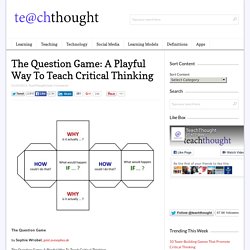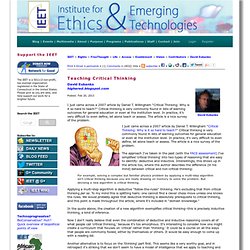

TeachThought sur Twitter : "The Question Game: A Playful Way To Teach Critical Thinking #teaching... The Question Game: A Playful Way To Teach Critical Thinking. The Question Game by Sophie Wrobel, geist.avesophos.de The Question Game: A Playful Way To Teach Critical Thinking Big idea: Teaching kids to ask smart questions on their own A four-year-old asks on average about 400 questions per day, and an adult hardly asks any.

Our school system is structured around rewards for regurgitating the right answer, and not asking smart questions – in fact, it discourages asking questions. In A More Beautiful Question: The Power of Inquiry to Spark Breakthrough Ideas, Warren Berger suggests that there are three main questions which help in problem solving: Why questions, What If questions, and How questions. Regardless of the question, the question needs to be phrased openly and positively in order to achieve positive results – a closed or negative question only raises bad feelings against each other.
Why questions help to find the root of a problemWhat If questions open up the floor for creative solutionsHow questions focus on developing practical solutions. TeachThought : 32 Characteristics Of ... 32 Characteristics Of High-Performing Classrooms. 32 Characteristics Of High-Performing Classrooms: Spotting The Holes In Your Teaching by Terry Heick Instructional design is the strategic creation of learning experiences through intentional planning, sequencing, and data-based revision of learning.

This process includes both the ways content is accessed, and the learning needs and objectives (and how they are determined) themselves. This puts instructional strategies, literacy strategies, curriculum mapping, standards unpacking, assessment design, digital literacy, and a dozen other facets of education beneath its umbrella. With that in mind, we’ve created the following 32 characteristics of higher-level instructional planning to help you spot the holes in your teaching. Technology Integration Cognitive Demand Lesson Planning Assessments Curriculum Mapping Learner Choice Classroom Management Student Support Image attribution flickr user flickeringbrad; 32 Characteristics Of A High-Performing Classroom. 4 Wonderful Critical Thinking Graphics. 40 Alternative Assessments for Learning.
When people think of assessment, pencils and bubble sheets may be the first things that come to mind.

Assessment does not always have to involve paper and pencil, but can instead be a project, an observation, or a task that shows a student has learned the material. In the end, all we really want to know is that the skill was mastered, right? Why not make it fun and engaging for students as well? 5 Alternatives To Bloom's Taxonomy For Teachers - This post is updated from an article we published in April.

At the end of the day, teaching is about learning, and learning is about understanding. And as technology evolves to empower more diverse and flexible assessments forms, constantly improving our sense of what understanding looks like–during mobile learning, during project-based learning, and in a flipped classroom–can not only improve learning outcomes, but just might be the secret to providing personalized learning for every learner. Ten Takeaway Tips for Teaching Critical Thinking. Teaching Critical Thinking. I just came across a 2007 article by Daniel T.

Willingham “Critical Thinking: Why is it so hard to teach?” Critical thinking is very commonly found in lists of learning outcomes for general education or even at the institution level. In practice, it’s very difficult to even define, let alone teach or assess. The article is a nice survey of the problem. I just came across a 2007 article by Daniel T. The approach I've taken in the past (with the FACS assessment) I've simplified 'critical thinking' into two types of reasoning that are easy to identify: deductive and inductive.
For example, solving a complex but familiar physics problem by applying a multi-step algorithm isn’t critical thinking because you are really drawing on memory to solve the problem. Applying a multi-step algorithm is deductive "follow-the-rules" thinking. In the quote above, the creation of a new algorithm exemplifies critical thinking--this is precisely inductive thinking, a kind of inference. A Model for Thinking.